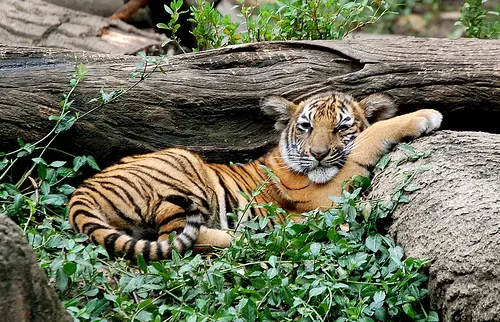Malayan Tiger
Found in the southern and central regions of the Malay Peninsular (modern day Malaysia and the southern tip of Thailand), the Malayan Tiger (Panthera tigris jacksoni) is one of 6 tiger sub-species. At last count, it is estimated that there are currently between 600-800 Malayan Tigers present in the wild, making it the most common species other than the Indochinese and Bengal tigers. Nevertheless, the Malayan Tiger is still sadly and endangered sub-species. Interestingly enough, it was only during 2004 when it was considered a sub-species after a study from the Laboratory of Genomic Diversity by Luo S-J et al.
This tiger is the national animal icon of Malaysia. However, the subspecies was named after Peter Jackson who is a tiger specialist. As you can imagine, the scientific name of the animal was hotly debated because the Malaysian Government and the Malaysian Association of Zoological Parks and Aquaria thought that it should be named after the region that it was found in instead of a person. As a result, the scientific name for the Malayan Tiger in Malaysia is the pantha tigris malayensis.
Physical Appearance
The Malayan Tiger looks just like any other tiger. However, there are some differences. It is one of the smallest existing tiger species, and its stripe pattern is similar to Indonchinese tigers. However, its size is similar to Sumatran tigers. On average, adult male tigers weigh 120 kg (264 pounds) are 237 cm (93.3 in) long. Adult females weigh 100 kg (220 pounds) on average, and are 200 cm (78.7 in) long.
Diet
Hungry Malayan Tigers like to eat livestock, barking deer, wild boar, and sambar deer. In Malaysia’s Taman Negara (a national heritage park), the tigers eat the sun bear. It is also thought that they prey on the tapir and the gaur, however whether it is a principal part of their diet is unknown.
Threats
Sadly, the main threat to these beautiful animals are humans. As Taman Negara develops more roads and has logging operations, these pose a threat to the tigers habitat. Also, the conversion of the forest to commercial or agriculture plantations has resulted between encounters between livestock and tigers. The loss of livestock can be quite high, and have been estimated to have cost between US$400,000 between the year 1993-2003 in Terengganu. Unfortunately for the farming community, this is one of the poorests areas in the Malaysian Peninsular. As a result of the confrontation between tigers and farm livestock, tigers are either killed by angry Farmers or villagers or are captured to be put into zoos.
Other Information
Sadly, scientific research on the Malayan Tiger is still lacking. Therefore information on its dietary preference (as mentioned above) is still lacking. Other information including communication, social structure, and morphological measurements also are lacking.
However, what we do know is that these endangered tigers live in low prey densities of about 1.1-1.98 tigers per 62 miles² (or 100 km²). Therefore, in order for the tigers to maintain a viable community, there needs to be a minimum of 6 females who are breeding so any reserves where Malayan Tigers habitate need to be over 1000km² (621 miles²).




